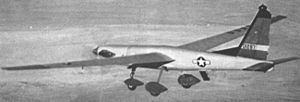LTV XQM-93
| XQM-93 | |
|---|---|

| |
| Role | Communications relay drone |
| National origin | United States |
| Manufacturer | Ling-Temco-Vought |
| First flight | February 1970 |
| Developed from | LTV L450F |
TheLing-Temco-Vought XQM-93was aremotely piloted aircraftdeveloped in the United States in the late 1960s and early 1970s for use as acommunications relayin the Vietnam War. A prototype flew in 1970, but the program was abandoned without producing a service-ready aircraft.
Design and development
[edit]In the late 1960s, following the early microwave HALE (High Altitude Long Endurance) vehicle studies, theUS Air Forceworked withLTV Electrosystems(laterE-Systems) under theCompass Dwellprogram to build an unmanned aerial vehicle (UAV) using much more conventional turboprop propulsion. At least part of the motivation or inspiration for this effort was derived from theIgloo Whiteprogram, which was a multiservice attempt to cut the flow of supplies from North Vietnam to South Vietnam through the network of paths and roads running through Cambodia and Laos known as the "Ho Chi Minh Trail".
Igloo White involved seeding the region with thousands of seismic and acoustic sensors, most of them air-dropped, which would pick up indications of traffic along the trail and report them back to a central command center in Thailand, which would dispatch air strikes in response. The sensors were battery-operated and had limited range, so airborne radio relay aircraft orbited above the battle area to pick up the signals and pass them on to the command center.
Originally, the radio relays wereLockheed EC-121 Warning Staraircraft, a military variant of theLockheed L-1049 Super Constellationfour piston engined aircraft, but these machines were expensive to operate. They were replaced byBeech Debonairesingle-engine light aircraft, modified for the radio relay role and given the military designation of QU-22A. They could be operated as drones, but apparently nobody trusted that as operational practice, and they were never flown unpiloted except as experiments.
LTV Electrosystems' development effort focused on an endurance aircraft that could be flown as a piloted aircraft or a UAV. A number of prototypes, including piloted and UAV versions, were built and flown. They were based on aSchweizer SGS 2-32sailplane design with major modifications bySchweizerto accommodate aPratt & Whitney Canada PT6A-34 turboprop engine, large fuel tanks, and operational payloads. The aircraft had fixed tricycle landing gear.
The first prototype, designated theL-450F,was piloted. It first flew in February 1970, but was lost in an accident on its third flight in March 1970, the pilot bailing out safely. A second L-450F was built and used to complete the flight test program. The third prototype, the first UAV variant, was designated theXQM-93and flew in early 1972. It had no cockpit or other provisions for piloted flight. It could carry a payload of 320 kilograms (700 pounds). The Air Force ordered four XQM-93s but it is unclear if they were actually delivered, since Compass Dwell was cancelled that year.
Surviving Airframes
[edit]
N2450F cn 002 is now on display in theVintage Flying Museumat Fort Worth Meacham International Airport.[1]
72-1287 is now on display in theFrontiers of Flight Museumat Dallas Love Field Airport.[2]
Specifications (prototype)
[edit]Data fromJane's All the World's Aircraft 1973–74[3][4]
General characteristics
- Length:29 ft 7 in (9.02 m)
- Wingspan:57 ft 0 in (17.37 m)
- Height:10 ft 8 in (3.25 m)
- Empty weight:2,400 lb (1,089 kg)
- Gross weight:5,300 lb (2,404 kg)
- Powerplant:1 ×Pratt & Whitney PT6A-34turboprop engine, 475 hp (354 kW)
Performance
- Cruise speed:105 mph (170 km/h, 91 kn)
- Stall speed:70 mph (114 km/h, 61 kn)
- Endurance:24 hours
- Service ceiling:50,000 ft (15,240 m)
- Maximum glide ratio:28
- Rate of climb:914 ft/min (4.6 m/s)
See also
[edit]Related development
Aircraft of comparable role, configuration, and era
Related lists
References
[edit]Notes
[edit]- ^Picture of the E-Systems XQM-93A (L-450F) aircraftArchived2015-05-09 at theWayback MachineRetrieved 21 May 2013.
- ^Ling-Temco-Vought L-450F, 72-1287 / 201287, Frontiers of Flight MuseumRetrieved 21 May 2013.
- ^Taylor 1973, p. 521
- ^Robinson, Anthony (1979).The Illustrated encyclopedia of aviation.Vol. 8. London:Marshall Cavendish.p. 854.ISBN978-0856855818.
This article contains material that originally came from the web articleUnmanned Aerial Vehiclesby Greg Goebel, which exists in the Public Domain.
Bibliography
[edit]- Taylor, John W.R., ed. (1973).Jane's All the World's Aircraft 1973–74.London, United Kingdom: Jane's Yearbooks.ISBN978-0-354-00117-5.
External links
[edit]- E-Systems GQM-93at Designation-Systems.Net
